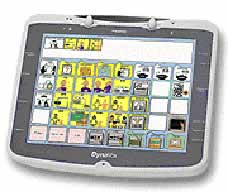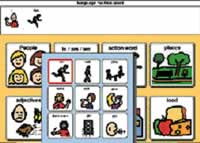DATI Assistive Technology Facts:
Augmentative and Alternative
Communication
"I may not like what you have to say, but I’ll defend to the death your right to say it." - Voltaire
What is assistive technology?
Assistive technology, or AT, is any tool that allows individuals with disabilities to use their own unique abilities to reach their goals. AT can range from low-cost tools such as a jar opener to more complex devices such as a power wheelchair or communication aid.
Infants, children, adults, and older persons with any type of disability can be aided by the use of AT.
What are augmentative and alternative communication devices (AAC)?
This category of assistive technology includes equipment and services that enhance face-to-face communication and telecommunication. Writing aids are also included in this group.
The devices allow a person to communicate when traditional speaking and writing are not effective. AAC equipment is customized to address a user’s motoric and communication needs.
Who is affected by a communication disability?
In the United States, there are approximately two million people who are able to hear but have little or no usable speech. This speech disability can be the result of autism, brain injury, cerebral palsy, mental retardation, severe language delay, stroke, or a neuromuscular disease such as ALS.
Who is able to benefit from an AAC device?
Any individual who has trouble communicating effectively by natural means may benefit from an AAC device. The devices are typically used by persons who do not speak, are difficult to understand, or have language retrieval issues. The equipment is used by people of all ages, with a variety of disabilities. Because many devices include pictures on the display, AAC device users do not need to be able to read.
Where can I purchase AAC?
While it may be tempting to select an AAC device from a catalog, this is unwise. It is important to find a device with features that match the user’s needs. This can only be done with the help of a team of professional with sufficient expertise. This team may include speech and language pathologists, occupational and physical therapists, audiologists and psychologists, among others.
Following an evaluation with the team, it is likely that they will recommend one or more devices for trial use before a final recommendation is made. If insurance payment is sought for the AAC device and related services, a physician’s prescription and documentation of medical necessity must be provided.
Acquisition of a device is merely the beginning, as the individual and those with whom s/he interacts will need training to maximize their use of the device.
Will the use of an AAC device inhibit speech development?
To the contrary, research has shown that communication devices actually encourage natural speech development by reinforcing language through visual, auditory, and motor techniques.
What types of devices are available to those with
severely
limited speech?
An AAC device presents communication options from which the user selects. Non-electronic communication boards/books might include letters, words, pictures, or even actual objects, depending on the user’s level of language understanding and use.
Electronic AAC devices range in complexity, from devices offering just a few selections to others supporting unlimited generation of language. Some devices offer text-to-speech capabilities, enabling the user to type a message that is subsequently spoken. Other devices represent language units in pictures; the user composes a message by selecting one or more pictures, and the selections can then be spoken. Several AAC devices interface with computers, allowing the user to control computer functions, including word processing and printing, with the AAC device.
Devices vary in the amount of language items they can contain, their speech output capabilities, their physical attributes (size and weight), the access techniques they can accommodate, and their cost.
What are some things I should consider before making
a purchase?
- What is the cause and course of my disability?
- Where will I use this equipment?
- How am I currently communicating and how can I modify this with an AAC device?
- Does this device accommodate my physical, sensory, and cognitive needs?
- What funding sources are available for this purpose?
 |
The DynaVox 3100 by DynaVox Systems is an AAC device with dynamic display and powerful communication software. |
 |
Attainment Company’s Personal Communication Book is ideal for manual communication systems. The easy-to-open book stays open until the page is turned. The book can be personalized with items important to the user. |
 |
Speaking Dynamically Pro by Mayer-Johnson is communication software that uses a computer as a powerful speech-output device. |
| Learn More: AT Fact Sheets | ||||
Adapted Toys |
||||
Aids for Low Vision |
||||
Aids for Daily Living |
||||
Assistive listening devices |
||||
Augmentative and Alternative Communication (AAC) |
Viewing |
|||
Computer Access |
||||
Seating, Position and Mobility |
||||
Switches and Environmental Control Units |
||||
Delaware Assistive Technology Initiative
Center for Applied Science & Engineering
University of Delaware/Alfred I. duPont Hospital for Children
PO Box 269, 1600 Rockland Road
Wilmington, DE 19899-0269
1(800) 870-DATI or (302) 651-6790
TDD: (302) 651-6794
FAX: (302) 651-6793
dati-ud@udel.edu
www.dati.org
